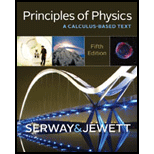
Concept explainers
(a)
To determine: The Earth’s orbital speed at aphelion.
(a)
Answer to Problem 55P
Answer: The Earth’s orbital speed at aphelion is
Explanation of Solution
Explanation:
Given information:
The maximum distance from the Earth to the Sun is
By the conservation of
The angular momentum at perihelion is given as,
The angular momentum at aphelion is given as,
Substitute
Substitute
Conclusion:
Therefore, the Earth’s orbital speed at aphelion is
(b)
To determine: The kinetic and potential energy of the Earth-Sun system at perihelion.
(b)
Answer to Problem 55P
Answer: The kinetic of the Earth-Sun system at perihelion is
Explanation of Solution
Section 1;
To determine: The kinetic energy of the Earth-Sun system at perihelion.
Answer: The kinetic energy of the Earth-Sun system at perihelion is
Explanation:
Given information:
The maximum distance from the Earth to the Sun is
Formula to calculate the kinetic energy of the Earth-Sun system at perihelion is,
Substitute
Conclusion:
Therefore, the kinetic of the Earth-Sun system at perihelion is
Section 2;
To determine: The potential energy of the Earth-Sun system at perihelion.
Answer: The potential energy of the Earth-Sun system at perihelion is
Explanation:
Given information:
The maximum distance from the Earth to the Sun is
Formula to calculate the potential energy of the Earth-Sun system at perihelion is,
Substitute
Conclusion:
Therefore, the potential energy of the Earth-Sun system at perihelion is
(c)
To determine: The kinetic and potential energy of the Earth-Sun system at aphelion.
(c)
Answer to Problem 55P
Answer: The kinetic of the Earth-Sun system at aphelion is
Explanation of Solution
Section 1;
To determine: The kinetic energy of the Earth-Sun system at aphelion.
Answer: The kinetic energy of the Earth-Sun system at aphelion is
Explanation:
Given information:
The maximum distance from the Earth to the Sun is
Formula to calculate the kinetic energy of the Earth-Sun system at aphelion is,
Substitute
Conclusion:
Therefore, the kinetic of the Earth-Sun system at aphelion is
Section 2;
To determine: The potential energy of the Earth-Sun system at aphelion.
Answer: The potential energy of the Earth-Sun system at aphelion is
Explanation:
Given information:
The maximum distance from the Earth to the Sun is
Formula to calculate the potential energy of the Earth-Sun system at aphelion is,
Substitute
Conclusion:
Therefore, the potential energy of the Earth-Sun system at aphelion is
(d)
To determine: Whether the total energy of the Earth-Sun system constant.
(d)
Answer to Problem 55P
Answer: Yes, the total energy of the Earth-Sun system is remains constant.
Explanation of Solution
Section 1;
To determine: The total energy of the Earth-Sun system at aphelion.
Answer: The kinetic energy of the Earth-Sun system at aphelion is
Explanation:
Given information:
The maximum distance from the Earth to the Sun is
Formula to calculate the total energy of the Earth-Sun system at aphelion is,
Substitute
Section 2;
To determine: The total energy of the Earth-Sun system at perihelion.
Answer: The kinetic energy of the Earth-Sun system at perihelion is
Explanation:
Given information:
The maximum distance from the Earth to the Sun is
Formula to calculate the total energy of the Earth-Sun system at perihelion is,
Substitute
Mathematically proved, the sum of kinetic energy and potential energy of the Earth–Sun system at perihelion is identical to the sum of kinetic energy and potential energy of the Earth–Sun system at aphelion. So the total energy of the Earth-Sun system is constant.
Conclusion:
Therefore, yes, the total energy of the Earth-Sun system remains constant.
Want to see more full solutions like this?
Chapter 11 Solutions
Principles of Physics: A Calculus-Based Text
- A capacitor with a capacitance of C = 5.95×10−5 F is charged by connecting it to a 12.5 −V battery. The capacitor is then disconnected from the battery and connected across an inductor with an inductance of L = 1.55 H . At the time 2.35×10−2 s after the connection to the inductor is made, what is the current in the inductor? At that time, how much electrical energy is stored in the inductor?arrow_forwardCan someone help me with this question. Thanks.arrow_forwardCan someone help me with this question. Thanks.arrow_forward
 Principles of Physics: A Calculus-Based TextPhysicsISBN:9781133104261Author:Raymond A. Serway, John W. JewettPublisher:Cengage Learning
Principles of Physics: A Calculus-Based TextPhysicsISBN:9781133104261Author:Raymond A. Serway, John W. JewettPublisher:Cengage Learning Physics for Scientists and Engineers: Foundations...PhysicsISBN:9781133939146Author:Katz, Debora M.Publisher:Cengage Learning
Physics for Scientists and Engineers: Foundations...PhysicsISBN:9781133939146Author:Katz, Debora M.Publisher:Cengage Learning Classical Dynamics of Particles and SystemsPhysicsISBN:9780534408961Author:Stephen T. Thornton, Jerry B. MarionPublisher:Cengage Learning
Classical Dynamics of Particles and SystemsPhysicsISBN:9780534408961Author:Stephen T. Thornton, Jerry B. MarionPublisher:Cengage Learning University Physics Volume 1PhysicsISBN:9781938168277Author:William Moebs, Samuel J. Ling, Jeff SannyPublisher:OpenStax - Rice University
University Physics Volume 1PhysicsISBN:9781938168277Author:William Moebs, Samuel J. Ling, Jeff SannyPublisher:OpenStax - Rice University Physics for Scientists and Engineers, Technology ...PhysicsISBN:9781305116399Author:Raymond A. Serway, John W. JewettPublisher:Cengage Learning
Physics for Scientists and Engineers, Technology ...PhysicsISBN:9781305116399Author:Raymond A. Serway, John W. JewettPublisher:Cengage Learning College PhysicsPhysicsISBN:9781305952300Author:Raymond A. Serway, Chris VuillePublisher:Cengage Learning
College PhysicsPhysicsISBN:9781305952300Author:Raymond A. Serway, Chris VuillePublisher:Cengage Learning





